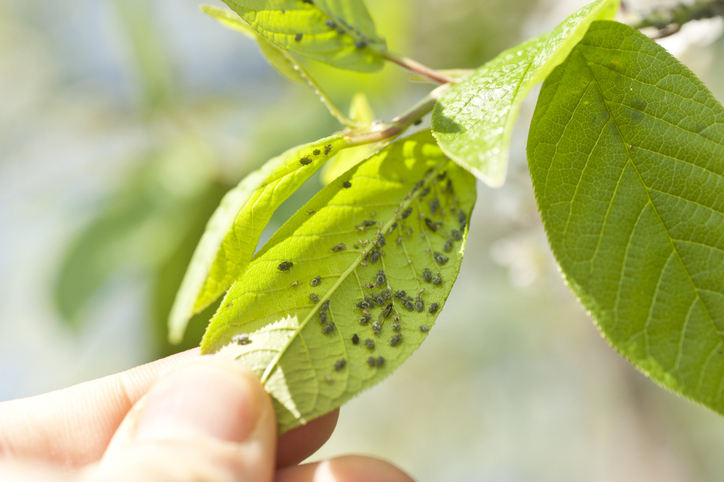What are aphids and spider mites and what do they do?
Aphids and spider mites are very different pests, but they share some similarities. Aside from being very tiny and very destructive, they’re very different in terms of identifying characteristics and the type of damage they cause. Aphids are very tiny bugs that feed off of the sap in your plants’ leaves. Spider mites, on the other hand, are teeny little arachnids that chew on the leaves themselves. Aphids are about 1/4″ in length, and they can be black, brown, grey, yellow, white, or light green. Spider mites are even smaller, at around 1/50″ in length, and they’re typically a reddish brown hue.
What types of plants are at risk?
Since aphids and spider mites feed on a variety of plants, they’re happy to move from one plant to the next in your yard. They form colonies that cluster together on the underside of leaves, which causes your plants to become weakened. Nearly all plants are at risk of attracting aphids and spider mites, and these pests are most active during the spring and summer months.
How do you detect aphids and spider mites?
Since they’re so tiny, it can be difficult to see aphids and spider mites until your plants begin to show damage. If you suspect that these pests are present, grab a magnifying glass and closely inspect your plant’s leaves. Aphids usually hang out near the leaves, stems or buds of your plants, and they leave a sticky residue behind that’s called honeydew. Ants especially love to eat honeydew, so if ants are present, you’ve probably got an aphid problem.
Spider mites can be found on the underside of leaves, and they create webbing that can reach from the leaves to the stem of your plants. This webbing can also stretch from one plant to another as spider mites travel. Another sign of spider mites is small holes on the leaves of your plants.
If an infestation persists, leaves will begin to turn yellow, and they’ll eventually fall off.
What are the best treatment options?
Here are some of the most effective ways to get rid of aphids and spider mites.
Aphids
- Spray leaves with cold water several times a day.
- Apply insecticidal soaps, horticultural oils, or neem oil to the leaves of affected plants.
- Spray leaves with a mixture of 1 quart water to 1 tsp dish soap several times a day for two weeks.
- Use pesticides for severe infestations.
Spider Mites
- Isolate the affected plants so they don’t spread.
- Spray the leaves and stems with water several times a day.
- Introduce neutral predators like ladybugs and other parasitic mites.
- Apply neem oil or insecticidal oil to the leaves.
- Apply insecticidal soaps that list potassium as the main ingredient.
Aphids and spider mites are very common pests that affect most plants and trees in the Denver area. They’re hard to spot, but without proper treatment, these tiny pests can wreak havoc on your plants. If you suspect an aphid or spider mite infestation, or if you’d like more information about how to keep your plants safe from pests, contact us today. Our experts at American Arbor Care would be happy to help.

